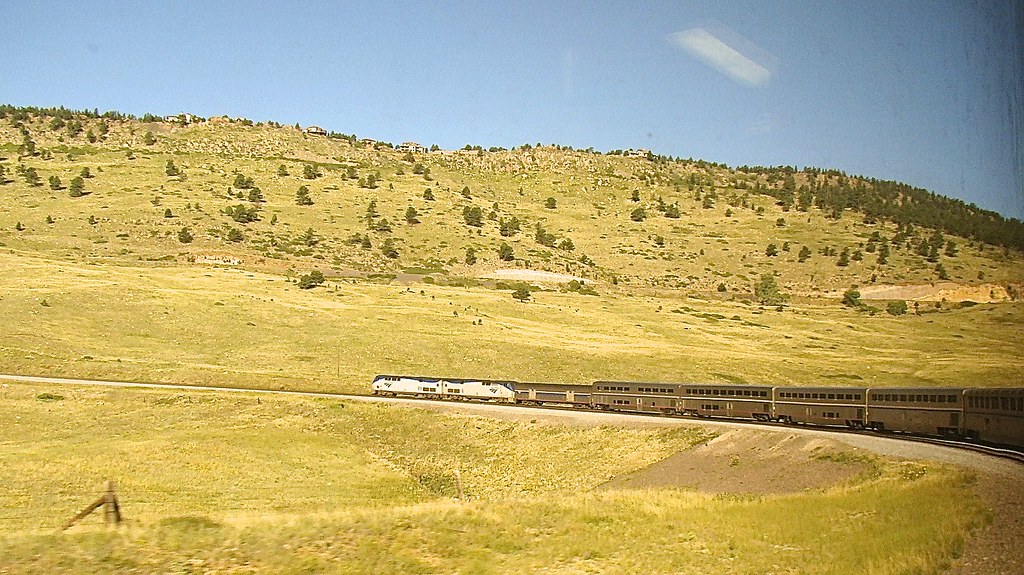
Big 10 Curve is a renowned train observation spot near Denver, Colorado, known for its sweeping views of the Rocky Mountains and the impressive engineering of the rail line. This curve is part of the Union Pacific Railroad and offers enthusiasts a chance to witness trains navigating the dramatic bend.
Photos
Sign in to upload photos
No Photos Yet
Be the first to share photos of this location!
Big 10 Curve (Denver) – Arvada, Colorado, USA | Train Spotting Location
Trainspotting Experience
From the public pull-offs along Colorado State Highway 93 or the adjacent county road network, railfans gain unobstructed sightlines both eastbound and westbound. Southbound (geographically compass-west) trains approach slowly from Rocky Flats, nose into the 10-degree curve, and then disappear toward Tunnel 1; northbound consists emerge silently from the tunnel portal before throttling up for the descent to Clay. Because of the grade, most freights pass at 20–25 mph, giving ample time to identify locomotives, distributed power units, and car types. Expect the ground to vibrate and turbochargers to whistle as multiple GEVOs or SD70ACe helpers dig in. Even a standard manifest can run 6,000–8,000 feet, and coal drags often exceed 100 cars, so the sight of a train occupying the whole arc is common. Ambient highway noise is low, and the nearest community is several miles away, letting rail sounds dominate the scene.
Landscape, Setting & Local Atmosphere
Big 10 Curve sits at roughly 7,100 feet above sea level on the eastern face of the Front Range. To the east stretch the open grasslands of the Colorado Piedmont; to the west rise red sandstone hogbacks and pine-dotted slopes. The curve itself is carved into a south-facing hillside, giving visitors wide vistas of the foothills and, on clear days, downtown Denver 15 miles distant. Vegetation is high-plains scrub: rabbitbrush, yucca, and scattered juniper. Summer afternoons bring dry heat, golden light, and sudden thunderheads that can yield dramatic photo backdrops. Winter visits require warm layers; chinook winds can exceed 40 mph, and snow squalls sweep off the Continental Divide, dusting the right-of-way in minutes.
Type & Frequency of Train Activity
The line is Union Pacific’s Moffat Route, a critical trans-Rocky Mountains artery. On an average weekday, railfans can expect 12–18 freight movements, a mix of:
• Unit coal trains from the North Fork Valley
• Manifest freights serving Utah and Pacific Northwest gateways
• Occasional intermodal or autorack extras
• Maintenance or geometry trains several times per month
Amtrak’s California Zephyr adds one passenger movement in each direction daily, usually mid-morning westbound and late afternoon eastbound. Power is predominantly UP AC4400CW, ES44AC, and SD70ACe, with BNSF run-through units appearing on coal sets. Distributed power on the rear or in-train is routine to counter the climb to the 6.2-mile Moffat Tunnel.
Best Angles for Photos & What Railfans Enjoy Most
The classic photo is taken from the dirt access road on the hillside above the tracks—here the entire “S” curve fits into a 24-mm frame, with trains wrapping 270 degrees around the photographer’s vantage. Morning light favors eastbound shots, illuminating the train’s nose and the Denver skyline in the distance; afternoons backlight locomotive exhaust and highlight dust kicked up by dynamic brakes. Telephoto lenses (100–400 mm) capture the locomotives emerging beneath the wind-screen of retired hopper cars that line the outside of the curve—a unique detail no other spot offers. A second angle, reachable by a short hike up the adjacent ridge, looks down on Tunnel 1’s east portal; from there, sunset light paints locomotives and sandstone in warm tones.
Historical or Cultural Relevance
Completed in 1904 as part of David Moffat’s Denver, Northwestern & Pacific Railway, the curve was engineered to tame the steep climb out of the plains toward the Continental Divide. Its name comes from the tight 10-degree curvature—a remarkable figure for a mountain main line designed for heavy, long trains. In the 1970s, the Rio Grande welded 33 surplus hopper cars together, filled them with concrete and rock, and installed them along the outer rail to act as a wind barrier; this improvised screen still stands, a favorite photographic touchstone and a living reminder of Rio Grande ingenuity. The site also played a minor role in Cold War history: nearby Rocky Flats produced nuclear components, and special security trains once used the line.
What Makes This Spot Different
Unlike many mountain railfan sites that require strenuous hikes or remote travel, Big 10 Curve offers front-row mountain railroading within 30 minutes of downtown Denver. The combination of slow, hard-working trains, sweeping curvature, and a built-in historical wind-screen of hopper cars creates visuals unmatched elsewhere on the Moffat Route. Few locations let observers see a full mile-long train simultaneously head-on, broadside, and tail-on without changing position.
Localisation
Coordonnées :39.854503, -105.251639
Seasonal Information
Big 10 Curve near Denver offers stunning views year-round. Spring and fall provide mild weather and vibrant scenery. Summer offers long daylight hours, while winter showcases snow-capped peaks. Check for special excursions and be prepared for weather changes.
Other Interesting Locations
Looking for more spots? Browse the complete list of train spotting locations.
Quick Information
Country
USA
Region / State / Province
Colorado
City
Arvada
Spot Type
Scenic Overlook
Best Times
The best hours to observe trains at Big 10 Curve are during daylight, especially morning (7-9 AM) and evening (5-7 PM) peak times for optimal visibility and frequency.
Access & Amenities
Parking
Not available
Shelter
Not available
Restrooms
Not available
